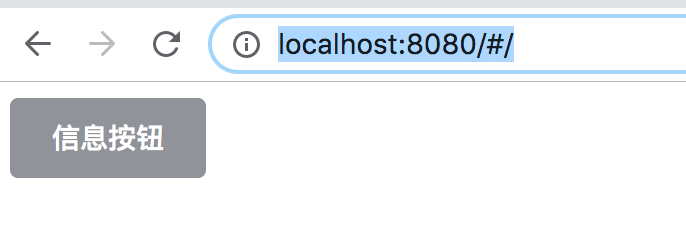您好,登錄后才能下訂單哦!
您好,登錄后才能下訂單哦!
這篇文章將為大家詳細講解有關前端Vue如何實現初始化及導航欄,小編覺得挺實用的,因此分享給大家做個參考,希望大家閱讀完這篇文章后可以有所收獲。
一、項目初始化
創建webpack模板項目如下所示:
MacBook-Pro:PycharmProjects hqs$ vue init webpack luffy_project ? Project name luffy_project ? Project description A Vue.js project ? Author hqs ? Vue build standalone ? Install vue-router? Yes ? Use ESLint to lint your code? No ? Set up unit tests No ? Setup e2e tests with Nightwatch? No ? Should we run `npm install` for you after the project has been created? (recommended) npm vue-cli · Generated "luffy_project".
根據提示啟動項目:
$ cd luffy_project/ $ npm run dev
由于在初始化時選擇了vue-router,因此會自動創建/src/router/index.js文件。
刪除Helloworld組件相關信息后,index.js文件內容如下所示:
import Vue from 'vue'
import Router from 'vue-router'
// @絕對路徑 檢索到 ...src/
// 如果Router當做局部模塊使用一定要Vue.use(Router)
// 以后在組件中,可以通過this.$router 獲取Router實例化對象
// 路由信息對象 this.$routes 獲取路由配置信息
Vue.use(Router)
// 配置路由規則
export default new Router({
routes: [
{
'path': '/'
}
]
})二、基于ElementUI框架實現導航欄
1、elementUI——適合Vue的UI框架
elementUI是一個UI庫,它不依賴于vue,但確是當前和vue配合做項目開發的一個比較好的UI框架。
(1)npm安裝
推薦使用 npm 的方式安裝,能更好地和 webpack 打包工具配合使用。
$ npm i element-ui -S
(2)CDN
目前可以通過 unpkg.com/element-ui 獲取到最新版本的資源,在頁面上引入 js 和 css 文件即可開始使用。
<!-- 引入樣式 --> <link rel="stylesheet" href="https://unpkg.com/element-ui/lib/theme-chalk/index.css" rel="external nofollow" > <!-- 引入組件庫 --> <script src="https://unpkg.com/element-ui/lib/index.js"></script>
使用CND引入 Element 需要在鏈接地址上鎖定版本,以免將來 Element 升級時受到非兼容性更新的影響。鎖定版本的方法請查看 unpkg.com。
2、引入 Element
在項目中可以引入整個Element,或者是根據需要僅引入部分組件。
(1)完整引入
在 main.js 中寫入如下內容:
import Vue from 'vue'
import App from './App'
import router from './router'
// elementUI導入
import ElementUI from 'element-ui'
import 'element-ui/lib/theme-chalk/index.css' // 注意樣式文件需要單獨引入
// 調用插件
Vue.use(ElementUI);
Vue.config.productionTip = false;
/* eslint-disable no-new */
new Vue({
el: '#app',
router,
components: { App },
template: '<App/>'
});以上代碼便完成了 Element 的完整引入。
嘗試在App.vue使用elementui的Button按鈕:
<template>
<div id="app">
<!-- 導航區域 -->
<el-button type="info">信息按鈕</el-button>
<router-view/>
</div>
</template>
<script>
export default {
name: 'App'
}
</script>顯示效果:

(2)按需引入
借助 babel-plugin-component,可以只引入需要的組件,以達到減小項目體積的目的。
首先安裝babel-plugin-component:
$ npm install babel-plugin-component -D
然后將.babelrc文件修改如下:
{
"presets": [["es2015", { "modules": false }]],
"plugins": [
[
"component",
{
"libraryName": "element-ui",
"styleLibraryName": "theme-chalk"
}
]
]
}如果只希望引入部分組件,如Buttion何Select,那么需要在 main.js 中寫如下內容:
import Vue from 'vue';
import { Button, Select } from 'element-ui';
import App from './App.vue';
Vue.component(Button.name, Button);
Vue.component(Select.name, Select);
/* 或寫為
* Vue.use(Button)
* Vue.use(Select)
*/
new Vue({
el: '#app',
render: h => h(App)
});3、導航欄實現
首先創建/src/components/Common/LuffyHeader.vue文件:
<template>
<!-- element-ui -->
<el-container>
<el-header height = '80px' >
<div class="header">
<div class="nav-left">
<img src="https://www.luffycity.com/static/img/head-logo.a7cedf3.svg" alt="">
</div>
<div class="nav-center">
<ul>
<li>
<a href="#" rel="external nofollow" rel="external nofollow" >
導航鏈接
</a>
</li>
</ul>
</div>
<div class="nav-right">
<span>登錄</span>
|
<span>注冊</span>
</div>
</div>
</el-header>
</el-container>
</template>
<script>
export default {
name: 'LuffyHeader',
data(){
return {
}
},
};
</script>再創建/static/global/global.css文件:
* {
padding: 0;
margin: 0;
}
body {
font-size: 14px;
color: #4a4a4a;
font-family: PingFangSC-Light; /*蘋果設計的一款全新的中文系統字體,該字體支持蘋果的動態字體調節技術*/
}
ul {
list-style: none;
}
a {
text-decoration: none;
}最后在App.vue中引入和使用組件:
<template>
<div id="app">
<!-- 導航區域 -->
<LuffyHeader/>
<router-view/>
</div>
</template>
<script>
import LuffyHeader from '@/components/Common/LuffyHeader'
export default {
name: 'App',
components:{
LuffyHeader
}
}
</script>顯示效果如下所示:

三、導航欄路由跳轉
1、組件創建和路由配置編寫
添加“首頁”、“免費課程”、“輕課”、“學位課”四大組件,因此創建如下文件:
src/components/Home/Home.vue src/components/Course/Course.vue src/components/LightCourse/LightCourse.vue src/components/Micro/Micro.vue
在src/router/index.js中引入組件,配置路由規則:
import Vue from 'vue'
import Router from 'vue-router'
// @絕對路徑 檢索到 ...src/
// 如果Router當做局部模塊使用一定要Vue.use(Router)
// 以后在組件中,可以通過this.$router 獲取Router實例化對象
// 路由信息對象 this.$routes 獲取路由配置信息
import Home from '@/components/Home/Home'
import Course from '@/components/Course/Course'
import LightCourse from '@/components/LightCourse/LightCourse'
import Micro from '@/components/Micro/Micro'
Vue.use(Router)
// 配置路由規則
export default new Router({
routes: [
{
path: '/',
redirect: '/home' // 訪問/,直接跳轉到/home路徑
},
{
path: '/home',
name: 'Home',
component: Home
},
{
path: '/course',
name: 'Course',
component: Course
},
{
path: '/home/light-course',
name: 'LightCourse',
component: LightCourse
},
{
path: '/micro',
name: 'Micro',
component: Micro
}
]
})2、導航鏈接編寫
修改 LuffyHeader.vue頁面,編寫導航鏈接:
<template>
<!-- element-ui -->
<el-container>
<el-header height = '80px' >
<div class="header">
<div class="nav-left">
<img src="https://www.luffycity.com/static/img/head-logo.a7cedf3.svg" alt="">
</div>
<div class="nav-center">
<ul>
<li v-for="(list, index) in headerList" :key="list.id">
<a href="#" rel="external nofollow" rel="external nofollow" >
{{ list.title }}
</a>
</li>
</ul>
</div>
<div class="nav-right">
<span>登錄</span>
|
<span>注冊</span>
</div>
</div>
</el-header>
</el-container>
</template>
<script>
export default {
name: 'LuffyHeader',
data() {
return {
headerList: [
{id: '1', name: 'Home', title: '首頁'},
{id: '2', name: 'Course', title: '免費課程'},
{id: '3', name: 'LightCourse', title: '輕課'},
{id: '4', name: 'Micro', title: '學位課程'}
],
isShow: false
}
}
}
</script>編寫headerList列表及列表中的導航對象,在 導航欄中遍歷對象獲取對應信息,顯示在頁面效果如下所示:

3、router-link路由跳轉
經過上面的編寫,雖然導航欄已經可以正常顯示,但是a標簽是不會做自動跳轉的。 需要使用 router-link 進一步改寫LuffyHeader.vue,使得路由跳轉得以渲染對應組件:
<template>
<!-- element-ui -->
<el-container>
<el-header height = '80px' >
<div class="header">
<div class="nav-left">
<img src="https://www.luffycity.com/static/img/head-logo.a7cedf3.svg" alt="">
</div>
<div class="nav-center">
<ul>
<li v-for="(list, index) in headerList" :key="list.id">
<router-link :to="{name:list.name}">
{{ list.title }}
</router-link>
</li>
</ul>
</div>
<div class="nav-right">
<span>登錄</span>
|
<span>注冊</span>
</div>
</div>
</el-header>
</el-container>
</template>
<script>
export default {
name: 'LuffyHeader',
data() {
return {
headerList: [
{id: '1', name: 'Home', title: '首頁'},
{id: '2', name: 'Course', title: '免費課程'},
{id: '3', name: 'LightCourse', title: '輕課'},
{id: '4', name: 'Micro', title: '學位課程'}
],
isShow: false
}
}
}
</script>使用to='{name:list.name}'設置命令路由,這樣點擊a標簽就可以跳轉了。顯示效果如下所示:

可以看到雖然點擊了輕課,但是和其他導航項樣式沒有任何分別,需要設置路由active樣式完成優化。
4、linkActiveClass設置路由的active樣式
linkActiveClass 全局配置 <router-link> 的默認“激活 class 類名”。
active-class 設置 鏈接激活時使用的 CSS 類名。默認值可以通過路由的構造選項 linkActiveClass 來全局配置。
(1)在路由配置linkActiveClass
在 src/router/index.js 中做如下配置:
import Vue from 'vue'
import Router from 'vue-router'
// @絕對路徑 檢索到 ...src/
// 如果Router當做局部模塊使用一定要Vue.use(Router)
// 以后在組件中,可以通過this.$router 獲取Router實例化對象
// 路由信息對象 this.$routes 獲取路由配置信息
import Home from '@/components/Home/Home'
import Course from '@/components/Course/Course'
import LightCourse from '@/components/LightCourse/LightCourse'
import Micro from '@/components/Micro/Micro'
Vue.use(Router)
// 配置路由規則
export default new Router({
linkActiveClass: 'is-active',
routes: [
{
path: '/',
redirect: '/home' // 訪問/,直接跳轉到/home路徑
},
......
{
path: '/micro',
name: 'Micro',
component: Micro
}
]
})(2)在LuffyHeader.vue中配置路由active樣式
<template>
......省略
</template>
<script>
......省略
</script>
<style lang="css" scoped>
.nav-center ul li a.is-active{
color: #4a4a4a;
border-bottom: 4px solid #ffc210;
}
</style>(3)顯示效果

5、hash模式切換為 history 模式
vue-router 默認 hash 模式——使用URL的hash來模擬一個完整的URL,于是當URL改變時,頁面不會重新加載。比如http://www.abc.com/#/index,hash值為#/index。hash模式的特點在于hash出現在url中,但是不會被包括在HTTP請求中,對后端沒有影響,不會重新加載頁面。
如果不想要這種顯示比較丑的hash,可以用路由的 history模式,這種模式充分利用 history.pushState API來完成URL跳轉而無需重新加載頁面。
(1)路由修改為history模式
修改 src/router/index.js 文件如下所示:
import Vue from 'vue'
import Router from 'vue-router'
// @絕對路徑 檢索到 ...src/
// 如果Router當做局部模塊使用一定要Vue.use(Router)
// 以后在組件中,可以通過this.$router 獲取Router實例化對象
// 路由信息對象 this.$routes 獲取路由配置信息
import Home from '@/components/Home/Home'
import Course from '@/components/Course/Course'
import LightCourse from '@/components/LightCourse/LightCourse'
import Micro from '@/components/Micro/Micro'
Vue.use(Router)
// 配置路由規則
export default new Router({
linkActiveClass: 'is-active',
mode: 'history', // 改為history模式
routes: [
{
path: '/',
redirect: '/home' // 訪問/,直接跳轉到/home路徑
},
.....
]
})使用history模式時,url就像正常url,例如http://yoursite.com/user/id,這樣比較美觀。
顯示效果如下所示:

(2)后端配置
但是要用好這種模式,需要后臺配置支持。vue的應用是單頁客戶端應用,如果后臺沒有正確的配置,用戶在瀏覽器訪問http://yoursite.com/user/id 就會返回404,這樣就不好了。
因此要在服務端增加一個覆蓋所有情況的候選資源:如果 URL 匹配不到任何靜態資源,則應該返回同一個 index.html 頁面,這個頁面就是app依賴的頁面。
關于“前端Vue如何實現初始化及導航欄”這篇文章就分享到這里了,希望以上內容可以對大家有一定的幫助,使各位可以學到更多知識,如果覺得文章不錯,請把它分享出去讓更多的人看到。
免責聲明:本站發布的內容(圖片、視頻和文字)以原創、轉載和分享為主,文章觀點不代表本網站立場,如果涉及侵權請聯系站長郵箱:is@yisu.com進行舉報,并提供相關證據,一經查實,將立刻刪除涉嫌侵權內容。